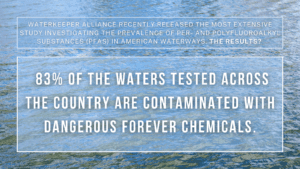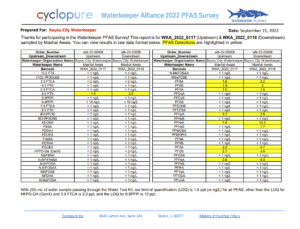First-of-its kind study by Waterkeeper Alliance found 83% of the waters tested across the country were contaminated by dangerous PFAS chemicals
READ THE REPORT HERE
On the 50th anniversary of the passage of the Clean Water Act, Waterkeeper Alliance released a groundbreaking new analysis of American waterways that sounds the alarm on a PFAS pollution emergency. In a test of 114 waterways from across the country, 83% were found to contain at least one type of PFAS—dangerous per- and polyfluoroalkyl substances that are widely linked to serious public health and environmental impacts. Bayou City Waterkeeper collected two samples on the White Oak Bayou, located in Northwest Houston, Texas. PFAS were found at both sites, with higher concentrations at the downstream location. Both our sampling locations were downstream of two Wastewater Treatment Plants (White Oak WWTP and Northwest WWTP). Our results indicate the need for increased sampling and monitoring of PFAS within our watershed.

Independent analysis indicates a shocking level of contamination, with 94 participating Waterkeeper groups confirming the presence of PFAS in their waterways. Waterways in 29 states and D.C. were found to be contaminated by at least one, but most frequently, many revealed the presence of up to 35 different PFAS compounds.

“When we began testing waterways for PFAS earlier this year, we knew that our country had a significant PFAS problem, but these findings confirm that was an understatement. This is a widespread public health and environmental crisis that must be addressed immediately by Congress and the U.S. Environmental Protection Agency (EPA). To begin tackling this urgent problem, Congress should start by passing the Clean Water Standards for PFAS Act of 2022, and EPA must prioritize using the funding from the Bipartisan Infrastructure Law to coordinate national monitoring and adopt regulatory standards for PFAS contamination. This report provides the information necessary for federal and state governments to take action and protect the health and safety of our communities,” said Marc Yaggi, CEO of Waterkeeper Alliance.
In some places, like creeks connected to the Potomac River in Maryland, the Lower Susquehanna River in Pennsylvania, and the Niagara River in New York, the level of contamination is thousands to hundreds of thousands times higher than what experts say is safe for drinking water. This is of particular concern as an estimated 65% of Americans source their drinking water from surface waters similar to those sampled.
These findings are an important step toward filling in a major data gap and validate the Alliance’s call to EPA for increased and widespread monitoring to gain a complete picture of PFAS contamination in all watersheds across the country.

What are PFAS?
Since at least the 1950s, PFAS have been widely used in manufacturing and are found in many consumer, commercial, and industrial products. These chemicals have entered our waterways for decades from polluting manufacturers who have benefitted from lack of regulation and loopholes. Experts estimate that nearly 30,000 industrial facilities, as well as airports, landfills, and other potential sources, discharge PFAS to surface waters or to wastewater treatment plants, which then discharge contaminated effluent into surface waters. Despite these threats, there are still no federal standards in place to stop or clean up this pollution. Findings from our sample results indicated elevated concentrations of 9 chemicals with elevated concentrations of PFHxA, PFOA, PFOS, and PFPeA, to name a few and these chemicals are known to cause health impacts. The results from our sampling are shared below:

Often referred to as “forever chemicals,” PFAS do not break down over time. Instead, these dangerous chemicals accumulate in people, wildlife, and the environment. As a result, PFAS have been found in surface water, air, soil, food, and many commercial materials. Scientific studies increasingly link these toxic chemicals to serious health conditions such as cancer, liver and kidney disease, reproductive issues, immunodeficiencies, and hormonal disruptions.
Despite serious health risks, there are currently no universal, science-based limits on the various PFAS chemicals in the United States. For many PFAS chemicals, the EPA has not even set a health advisory limit that would give the public a baseline to determine what amount of PFAS is unhealthy in drinking water. In most cases, the EPA is not doing adequate monitoring for these chemicals, which is why these findings are so unique and important.
Drinking water utilities and wastewater treatment plants are poorly equipped to cope with the onslaught of these chemicals and require financial assistance as upgrades required for removal are extremely expensive. By the end of 2023, EPA is expected to set drinking water standards for PFOA and PFOS that will require U.S. drinking water utilities, many of which are already in need of substantial infrastructure repairs or replacement due to decades of funding shortfalls, to undertake costly upgrades even as polluting and profit-making industries continue to contaminate public trust waters without recourse. A continued failure of regulatory agencies to prevent polluting industries from dumping PFAS into their waste streams, or to hold them responsible for cleanup costs, means that the financial burden is passed down to water and wastewater utilities and, by extension, everyday people, who pay for these services.
This data plainly demonstrates that Congress and EPA must act with urgency to control persistent PFAS contamination across the country. The current lack of oversight puts the health and safety of communities and ecosystems across the nation at risk and results in costly cleanup and treatment activities to remove PFAS contamination after it has occurred. To learn more, visit waterkeeper.org/pfas
